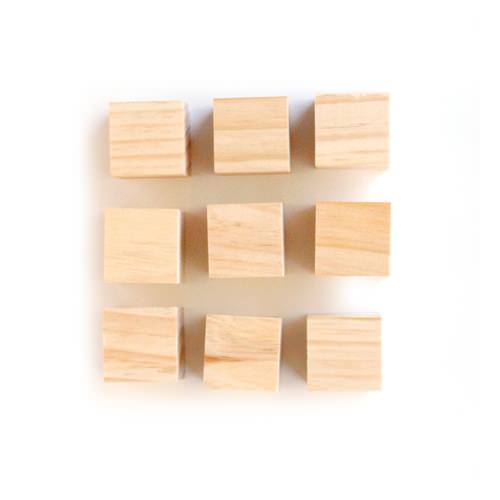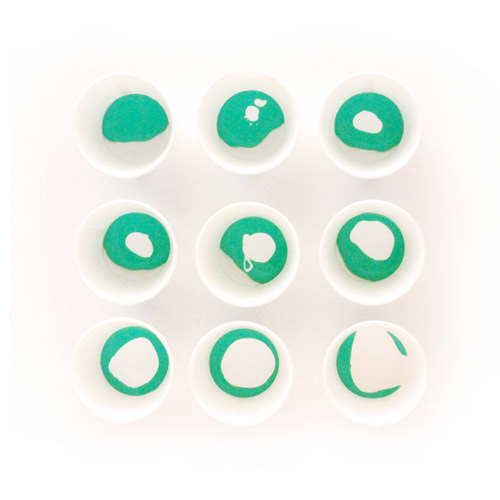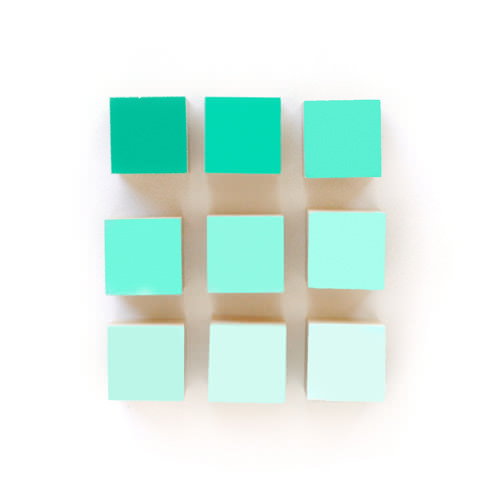
School may be out for the summer but that doesn’t mean you child’s learning has to come to halt. Especially if it’s fun and comes in the form of a toy! I’ve always been drawn to Montessori learning toys as they are as beautiful as they are educational. I love their color tablets and have wanted to create our own take on this concept.
We decided to paint 9 wooden blocks in various hues and gradients. We love the result and have been having so much fun playing and learning about the names of colors, color tone and gradation, hue matching, linear ordering and just simply appreciating that color is fun and beautiful!

Materials
To get started on this, you will need 9 wooden blocks (you could also use 6 blocks, which would also work well). We found our 1 1/2″ blocks at a local craft store which proved to be just the perfect size for little hands. You will then need to pick six colors to work with. We used craft acrylic paints for this. Make sure that these colors are pretty dark as you will be creating 8 lighter hues from this base color and you want to be sure to have a good range to work with.

You will also need a good deal of white paint which will be added to each color. And of course you’ll need a paint brush or small sponge brush (which is what we used) to apply the color.

Painting the Blocks
To paint the blocks in a nice gradient pattern you’ll need to start with the original dark hue and then gradually add more white to the paint until you are satisfied with the colors. Once you are happy with your color variations go ahead and apply the paint to one side of each block.
I find that a small sponge brush does a good job of keeping the lines nice and tight. I suggest applying a few thin coats to keep the paint from globbing up and dripping over as opposed to one opaque coat with a lot of paint.

Let the paint dry (or blow dry with a hair dryer to speed things up) and then rotate all the blocks to one side and then do the same thing again with a different color. I tried to also rotate my blocks so that none of the darkest or lightest shades were on the same block.

Playing with the Blocks
Now for the fun part! There are no hard and fast rules to playing with these fun and colorful blocks, but if you want to teach your child specific concepts about color, there are a number of of things you can do. You ask them “What is the darkest shade of this hue?”. “What is the lightest?”. “What color looks like it could be right in the middle?”. You could then sit next to them and demonstrate how to line up all the blocks from darkest to lightest, pointing out the subtle variations that just one hue can create. Then have them give it a try on their own. I did this with my six year old and he had a lot of fun with it. He initially needed help lining up all nine color variations but he enjoyed seeing how it all came together once things were in their correct order.
For a younger child (Little O is 3yrs) you can eliminate a number of the colors and just use the darkest, lightest and middle hue. You can then ask the same questions you did earlier, being sure to point out the variation of dark to light, etc.

The options for these blocks are endless. You can have your child put a number of dark hues together as well as light hues. Then add the middle color to see how things line up. Then just have fun with it and explore the different things you can do and create. And as a bonus, you’ll love all the fun colors these blocks will bring to your home, even when strewn about the floor!